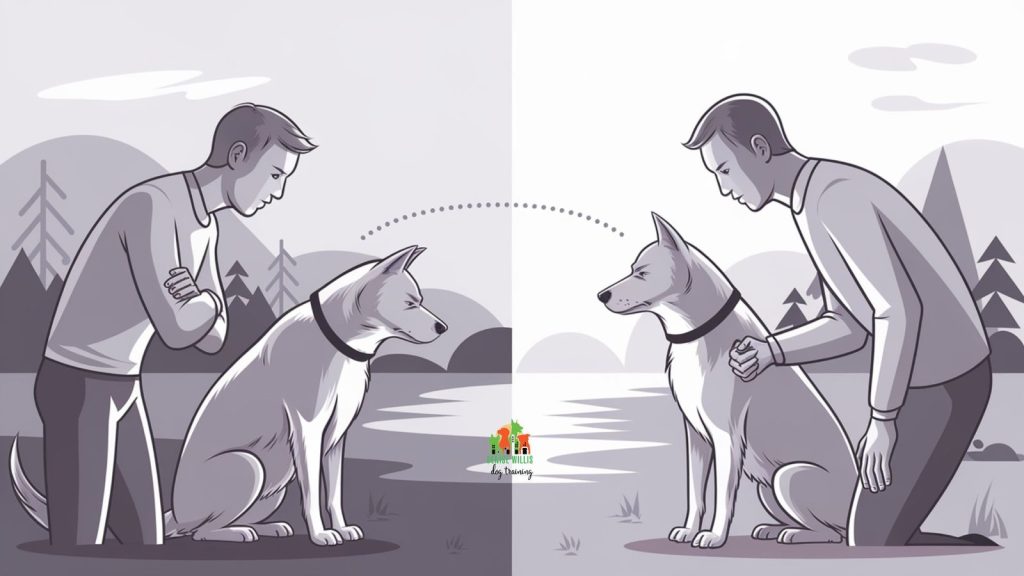Nonverbal Communication in Dogs: How to Understand Behavioral Cues

Decoding Your Dog’s Body Language
Dogs may not speak our language, but they communicate emphatically through their behavior. Nonverbal communication in dogs is intricate and filled with emotional richness. By observing their body language and reactions, owners can decode their furry friends’ feelings and intentions. This understanding can pave the way for a deeper bond between humans and their canine companions, enhancing everyday interactions and ensuring a harmonious coexistence.
Understanding these behavioral cues is pivotal for every dog owner. Here are some crucial elements to consider when interpreting your dog’s nonverbal signals:
- Tail Position: A wagging tail often indicates excitement and happiness, particularly if it moves in wide arcs. However, a tail tucked tightly between the legs may signify fear or submission. For example, when encountering a stranger, it’s not uncommon for dogs to display a slightly lowered tail, demonstrating their discomfort in the situation.
- Facial Expressions: Dogs exhibit a range of emotions through their facial expressions. A relaxed face, with soft eyes and a slightly open mouth, indicates ease and contentment. In contrast, a tense expression with narrowed eyes or bared teeth signals distress or aggression. Observing these nuances can help prevent dangerous encounters, especially during playdates or at dog parks.
- Ears and Eyes: A dog’s ears can tell you a lot about their mood. Erect ears may signal excitement or alertness, while ears pulled back could indicate submission or anxiety. Additionally, wide eyes can reflect curiosity or fear, depending on the context. For instance, if your dog suddenly freezes with wide eyes while on a walk, it may have spotted something unsettling.
These cues not only show us what our dogs are feeling but also prevent misunderstandings in everyday situations. For instance, a dog that backs away with lowered ears is likely feeling threatened or scared. By recognizing such signals, you can avoid provoking fear responses and instead create a more nurturing and secure environment for your pet.
Moreover, a keen awareness of your dog’s body language can significantly improve training outcomes. When a dog feels understood, it is more likely to engage positively with commands and instructions. Thus, trusting your instincts combined with an understanding of canine nonverbal cues can help in overcoming behavioral issues and reducing anxiety, ultimately fostering a stronger bond between you and your canine companion.
In this article, we’ll delve deeper into the world of canine nonverbal communication. Discover how paying attention to these silent signals can improve training, reduce anxiety, and create a more fulfilling relationship with your dog. By taking the time to learn their silent signals, you empower yourself to be the best companion possible, making both your lives more enjoyable and stress-free.

DIVE DEEPER: Click here to discover the benefits of companion animals
Understanding Canine Emotional Signals
Just like humans, dogs experience a complex range of emotions that guide their behavior. Nonverbal communication in dogs is critical as it allows them to express joy, fear, anxiety, and even aggression without uttering a single bark. The key to unlocking this silent language lies in careful observation and interpretation of their behavior and body language. By understanding these emotional signals, you can cater to your dog’s needs and create an environment where they feel safe and loved.
A fundamental aspect of this communication involves the dog’s primary means of expressing their feelings: their body posture. Whether they are standing, sitting, or lying down, a dog’s posture can reveal their current emotional state:
- Relaxed Stance: A dog that is in a relaxed state will have a neutral stance with limbs uncrossed and a loose body posture. This often signifies that they feel comfortable and confident in their surroundings.
- Alert Posture: When a dog stands tall with an erect body and stiff legs, they may be in a heightened state of awareness. This behavior can indicate curiosity or readiness to react to whatever is happening around them.
- Submissive Position: If a dog lies down or rolls over to expose their belly, it typically reflects submission and trust in their environment. This signal aims to indicate that they are not a threat but rather vulnerable and seeking acceptance from their peers.
Moreover, the way dogs use their paws can also convey messages. For example, a dog that places a paw on you may be seeking attention or intimacy, while a dog that suddenly raises a paw can indicate hesitation or uncertainty, often accompanied by a tilt of the head. Recognizing these subtle movements can foster an understanding of your dog’s mental state and facilitate better interaction.
Equally important is the dog’s interaction with their environment. When they engage in play with other dogs or humans, their body language changes significantly. A dog that bows with front legs stretched forward and hindquarters up is signaling an invitation to play. Meanwhile, a dog that growls or snaps while in play may be expressing discomfort or an overstimulated state. Such context-driven cues are essential for ensuring safe playtime.
Understanding your dog’s body language doesn’t only benefit your relationship but also contributes to their overall well-being. Recognizing signs of stress or discomfort, such as yawning, licking lips, or excessive panting, can inform you when your dog needs a break or a change in environment. These insights can prevent negative experiences, ensuring a strong, positive bond with your furry friend.
The ability to perceive and interpret your dog’s nonverbal cues can be a transformative experience. In the following sections, we’ll continue our exploration by shedding light on various social interactions and how they influence your dog’s behavior, ultimately enhancing your ability to connect with them in meaningful ways.
Understanding Key Nonverbal Signals in Canines
In the realm of canine communication, nonverbal cues are critical for deciphering a dog’s emotional state and intentions. Recognizing these signals can dramatically enhance your relationship with your pet. Different forms of body language, including posture, tail movements, and facial expressions, serve as indicators of what a dog may be feeling or thinking. For instance, a wagging tail can express excitement, but the speed and height of the wag can vary based on the dog’s mood. A slow wag might indicate uncertainty, while a high, fast wag usually signifies joy. Furthermore, the position of a dog’s ears can offer insight into their emotional state; forward ears suggest curiosity or excitement, whereas pinned-back ears can indicate fear or submission. Another crucial aspect of nonverbal communication is the dog’s body posture. A relaxed dog with a loose stance generally signifies comfort and security, while a rigid body may signal anxiety or aggression. Paying attention to these subtle changes in behavior allows dog owners to respond appropriately and foster a safer environment. To truly understand your dog’s feelings, it’s essential to not only observe their body language but also correlate it with the context of the situation. A barking dog may not always be demanding attention; sometimes, it simply reflects an instinctive response to perceived threats. Incorporating these observations into your daily interactions with your pet can lead to a significant improvement in training effectiveness and neighborly coexistence. This understanding not only strengthens the human-animal bond but also promotes the dog’s overall well-being. By learning to read behavioral cues, you empower yourself to become a better handler and companion. In the following sections, we will explore specific cues in more detail, providing you with tools to interpret and react to your dog’s communication.
| Signal Type | Meaning |
|---|---|
| Tail Wagging | Indicates excitement or happiness; the speed and height reveal different emotions. |
| Ear Position | Forward ears show interest, while backward ears reflect fear or submission. |
| Body Posture | A relaxed stance indicates comfort, whereas a rigid posture can suggest anxiety or aggression. |
| Facial Expressions | Eyes and mouth movements convey a dog’s emotional state, such as excitement or fear. |
Continuously observing and understanding these nonverbal cues will create a more harmonious existence between you and your dog, ultimately allowing both to thrive. Each signal your dog presents deserves attention, as it is a vital part of your ongoing communication journey.
DISCOVER MORE: Click here to learn how pets can enrich children’s lives
Exploring Canine Social Interactions
To fully grasp the essence of nonverbal communication in dogs, we must also delve into how they interact with their fellow canines and humans. Social interactions are a rich source of behavioral cues that reflect their emotional states and intentions. Dogs, being pack animals, are naturally inclined to communicate through their body language and vocalizations, which can vary significantly depending on the context of their interactions.
One of the most prominent displays of social communication is the dog greeting ritual. When two dogs meet, they engage in a series of nonverbal exchanges that are crucial for establishing social hierarchies and comfort levels. A common behavior is the “sniffing protocol.” Dogs will often approach each other and sniff each other’s faces, bodies, and hindquarters. This behavior allows dogs to glean important information about each other’s emotional and physical state, including health, gender, and reproductive status. Understanding this greeting can help dog owners recognize when their pet is feeling curious and open to socializing or when they feel threatened and might react defensively.
An essential element of these interactions is how dogs respond to human cues. Research indicates that dogs are remarkably adept at interpreting human body language, making them unique companions. For instance, if you raise your hand to pet your dog, they may tilt their head, reposition their body, or even wag their tail to signal happiness or excitement. Conversely, if you approach them with an angry or stressed posture, dogs can pick up on that tension, often leading to signs of distress, such as cowering or retreating.
The Role of Tail Positioning
Another critical indicator in canine communication is tail positioning. The tail can serve as an emotional barometer, effectively indicating a dog’s mood:
- High and Wagging: A tail held high and wagging enthusiastically generally signifies happiness and excitement. This sign often accompanies friendly approaches to both humans and other dogs.
- Low and Slowly Wagging: A low tail that moves slowly may indicate insecurity or submission. This signal could be a dog’s way of expressing that they are not a threat, especially in potentially aggressive situations.
- Stiff and High: A tail that is held stiffly upright might suggest dominance or assertiveness. This behavior can sometimes lead to confrontation with other dogs as it may signal aggression.
Understanding these diverse tail signals can be instrumental in navigating both social settings with other dogs and day-to-day interactions with humans. Moreover, dog owners can enhance their communication skills through observations in varying environments—public parks, dog-friendly events, or even at home with multiple pets.
Recognizing Stressful Interactions
A significant factor in a dog’s social interactions is the ability to identify signs of discomfort or stress. During playtime, a dog’s behavior can shift from enthusiastic to tense. Warning signs may include:
- Freezing: A dog that suddenly freezes during play may be overwhelmed and need a moment to process their emotions.
- Excessive Yawning or Licking: These behaviors are often indicators of stress and may suggest a dog needs space or a break.
- Averting Gaze: If a dog turns its head away or avoids direct eye contact, it may feel threatened, and this subtle cue is their way of saying they wish to disengage.
By understanding and recognizing these crucial signals, dog owners can better support their pets during interactions, ensuring that playtime remains enjoyable and safe. Taking the time to read these behavioral cues not only enhances the owner-dog relationship but also equips individuals to foster a more harmonious environment for all canine companions involved.
DISCOVER MORE: Click here to learn about nourishing your pet
Conclusion: Mastering Canine Nonverbal Cues
Understanding nonverbal communication in dogs is essential for fostering a strong bond between pets and their owners. By recognizing and interpreting behavioral cues, such as tail positioning, body posture, and facial expressions, dog owners can not only enhance their relationship with their furry companions but also ensure their well-being in social situations. This ability to decode the silent language of dogs empowers owners to respond appropriately to their pets’ emotional states, reducing the likelihood of stress or conflict during interactions.
Moreover, observing how dogs interact with each other provides valuable insights into their social dynamics. The nuances of play, such as frozen moments or the implications of sniffing, reveal much about a dog’s comfort level and intentions. By understanding these signals, owners can create a more positive environment, be it during playdates or casual encounters at the park. Just as humans rely on nonverbal cues in communication, our canine companions do the same—making it crucial for owners to tune into these signals.
As more research highlights the sophistication of canine communication, it becomes increasingly clear that dogs possess an incredible ability to read human emotions as well. By remaining aware of our own body language and behaviors, we can cultivate more effective communication channels with our pets. Ultimately, nurturing this understanding between humans and dogs not only enriches lives but also reinforces the unique and reciprocal bond we share with these remarkable animals. To deepen your skills in recognizing and interpreting these signs, continue to observe, engage, and learn about the vital role of nonverbal communication in the world of dogs.


